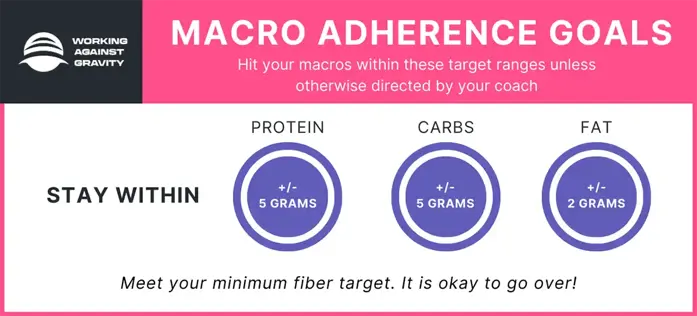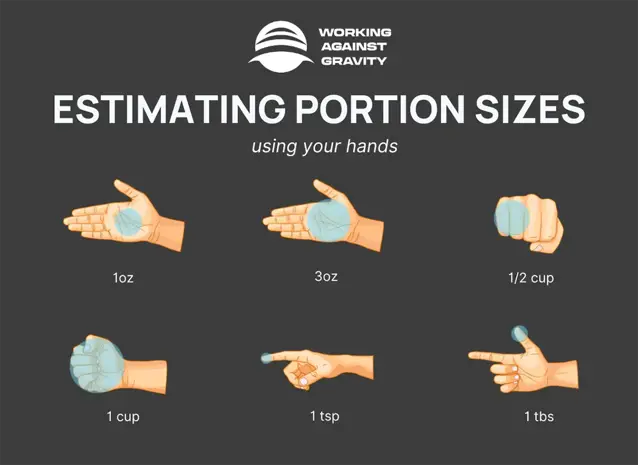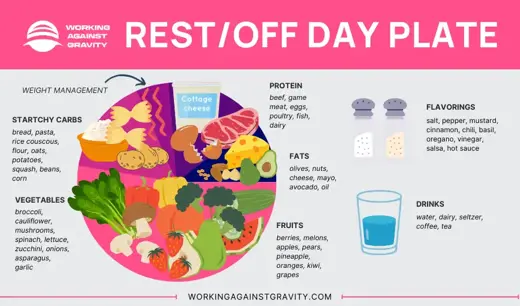
There is a time and place for precisely tracking your macros. There is also a time and place for finding alternatives to macro tracking that keep you accountable for your nutrition choices without the extra math, planning, and phone apps.
At WAG Nutrition, we believe that tracking macros is a great way to learn what is in your food and determine what works best for your body, given your performance, body composition, and overall health goals. But, we also believe that there are alternatives to macro tracking to utilize when macro tracking isn't one of those goals.
Today, we're sharing the benefits of macro tracking, when it may (or may not) not work, how to decide what is best for you, and clear and creative alternatives to macro tracking.
![]()
Pros and Cons of Macro Tracking
What is counting macros?
Advertisement
“Counting macros” means tracking the precise amounts of protein, carbohydrates, and fats consumed daily. Because each macronutrient plays a different role in the body, tracking macros in prescribed ratios is a more effective way to “count calories.” Macro tracking gives you more control over where your calories come from.
When Macro Tracking May Work
You can tweak macro ratios depending on your unique goals. Whether you want to lean out, improve physical performance, or learn more about what is in your food, macros can help you achieve your goals. Understanding which macros make up your foods can help you optimize your diet to achieve your desired result (heavier lifts, more defined abs, etc.).
Tracking macros also ensures a balanced diet. When calories are more specifically designated to each macro, overall intake comes from various sources (meat, veggies, fats, etc.). To find the exact amount of macros you need, calculate them for free here or learn more about working with a nutrition coach with unparalleled knowledge and experience in setting and adjusting macros based on your unique wants and needs.
When Macro Tracking May Not Work
On the flip side, macro tracking doesn’t work for everyone all the time.
Advertisement
To experience the benefits of macro tracking, you have to be willing to put in the time to learn about macros and learn how to track them properly. You'll need to learn what foods fall under which macro category, how to accurately weigh and measure your food, and a method for entering all that data so you can keep track of it—this takes a relatively high initial time investment as you make your way through the learning curve.
At WAG, our coaches help ease this curve by providing personalized feedback and suggestions based on your schedule, body, macros, and goals.
Because of the initial learning curve and time commitment, there may be times in life when macro tracking may not be the most effective choice. Here are some examples:
- If you are going through a big life change such as a move, new career, or relationship change
- If you have a substantial amount of stress in your life
- If you are brand new to the wellness/nutrition space and want to start with something simpler
- If you have health issues to consider (*Note: we always recommend consulting your doctor before beginning any nutrition program)
You may also choose not to track if you've been diligently counting your macros and want to take a step back after reaching a specific weight or performance goal. When your goals are more flexible, you have more wiggle room to let go of precise tracking.
Advertisement
Creative Alternatives to Macro Tracking
Whether you want to ease into nutrition before tackling macro tracking or you want to transition out of macro tracking, the strategies below will help you get there.
Increase Your Macro Ranges
If you're down to give tracking a shot but feel restricted by smaller ranges (at WAG, we suggest ending each day with 5g of protein and carbs and within 2g of fat for “optimal” consistency), try widening your target ranges.

For example, you could aim for a range like +/-10 for carbs and protein and +/-5 for fat. If that still feels tough, try +/-20 and +/-10, respectively.
Estimate Macro Intake
Maybe you're down to aim for targets, but getting out a food scale for every single meal isn’t something you're willing or able to do.
Advertisement
If weighing and measuring food is too overwhelming or time-consuming at first, start by estimating your intake based on your general food knowledge. It may be easier to estimate using cups and spoons vs. grams and ounces as these tend to be more visual measurements.
Speaking of visuals, here is a great resource to save!

If you decide to go this route, it is important to manage expectations—it may take a bit longer to reach your goal if you allow for more wiggle room. But, if estimating helps you stay consistent and excited about your journey, you will ultimately be more successful with slow, steady progress.
If you have a very time-dependent goal or want to see progress as quickly as possible, consider that this isn’t the most precise option, and actions and expectations need to align in terms of how fast (or slow) you may see progress.
Advertisement
So much depends on your willingness to work to reach your goal, and a coach can help you decide what will make your journey sustainable long-term and minimize frustration along the way.
Track General Intake
If hitting macro targets is overwhelming, that doesn’t mean you need to forgo tracking altogether. Try tracking your normal daily intake of food without aiming for targets. This will help you learn what is in your food and get to know your tracking app (we love MacrosFirst!) without the pressure of aiming for exact numbers.
Start with One Macro
If you want to track, but everything feels like a big jump, try tracking ONE macro instead of all three. At WAG, we typically start with protein, as it is the easiest to undereat if you're not diligent. Protein will also keep you fuller and help stabilize your blood sugar, which will decrease cravings for other, less healthy options.
Utilize a Meal Plan
If deciding what to eat and building your own meals sounds like the opposite of fun, consider creating a meal plan based on your goals, gender, and body weight.
At WAG, an initial meal plan is included with our Nutrition Coaching Plus membership and as an add-on for all members. These meal plans are completely personalized to your coach-prescribed macros and food preferences.
Advertisement
We also offer Custom Meal Plans to anyone who wants to try them and make their decision-making quick and easy. These plans are customized based on your starting weight, activity, age, biological sex, and more!
Build a Balanced Plate
If you're not ready to track your food, start by learning how to build a balanced plate. Here is a great starting place:

Set Meal Goals
You can set smaller, measurable goals that hold you accountable for meal preparation. For example, you could set a goal of eating protein at every meal or veggies with at least two meals a day.
Advertisement
Can I Lose Weight Without Tracking Macros?
Have you ever wondered, “Can I still lose weight without tracking macros?”
The quick answer is yes—it is possible to lose weight without tracking macros—especially if you're new to the nutrition game. But, if you're already lean or looking to lose "those last 5 pounds", you may need something more precise to see progress.
Different goals require different levels of dedication and adherence, and making sure your actions and expectations align is the key to making progress without massive frustration.
Tracking macros is only one piece to a much larger puzzle that considers your overall health and wellness and how it relates to lifestyle factors. Consider:
- What is your general calorie intake vs. expenditure?
- What does your stress look like?
- How much water are you drinking each day?
- What does your movement/exercise routine look like?
- How much sleep do you get on average?
These things also impact body composition and performance and can play a role in how quickly you reach your goal.
Advertisement
Additional Ways to Build Consistency
Outside of the alternatives to macro tracking presented above, you can set additional goals and ways to build consistency over time.
Some other measurable goals to focus on could be:
- Creating a consistent morning practice to include meditation/reflection or journaling
- Setting a goal for water intake throughout the day
- Setting reminders on your phone to step away from work and eat meals throughout the day
- Creating a consistent evening winddown routine before bed
- Aiming to be in bed to go to sleep by a certain time at night
There are many moving pieces to deciding if and when macro tracking best serves your goals. It takes some time and experimentation to nail down what works for you. And if you want some help, we're here for you!
Get a WAG Coach
Working Against Gravity has led the macro tracking and health space for over a decade. Our team doesn’t just understand the science of nutrition—we’ve spent years mastering the art of tailoring it to fit your life. That means no cookie-cutter plans, just real strategies that have worked for over 30,000 people.
Choose from our membership options and start working with an expert 1-on-1 coach today.



